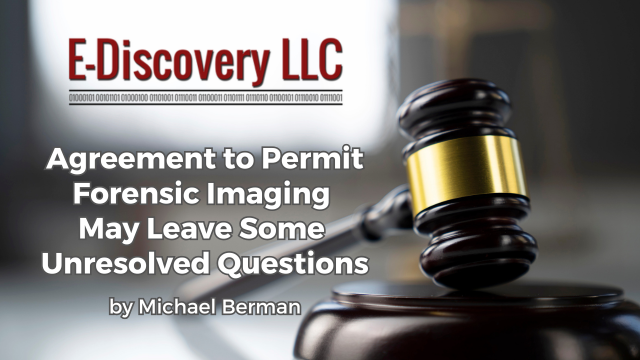
[EDRM Editor’s Note: The opinions and positions are those of Michael Berman.]
In HET MCPS, LLC v. AutoFlex, Inc., 2025 WL 1615459 (D. Md. June 6, 2025), plaintiffs alleged that defendants interfered with plaintiffs’ contract and customer relationships.
In this opinion, the Court addressed, among others, plaintiffs’ motion for forensic imaging. “Plaintiffs contend that Defendants have failed to comply with their discovery obligations and request that the Court permit third-party forensic imaging of relevant electronic devices (e.g., computers and phones used by AutoFlex and its principal, MacDonald) and associated email accounts and that [defendant] AutoFlex bear the cost of this imaging.” [Emphasis added; cleaned up].
In their response, defendants consented to forensic imaging, but only if plaintiffs would pay the costs.
The parties then agreed: “Plaintiffs agree to bear the costs of imaging in the first instance, but reserve all rights to later seek to recover costs and expenses associated with the Imaging Motion, including (but not limited to) recovering costs and expenses based on further discovery violations and/or evidence of spoliation.” The parties also confirmed that “any forensic imaging should, if possible, be done remotely, or, if not remotely, onsite at the Defendants’ place of business to avoid any undue burden to Defendants.”
The Court wrote:
Plaintiffs’ Motion for Forensic Imaging … is GRANTED without opposition, subject to the modification that Plaintiffs agree to bear the cost of imaging in the first instance, but reserve all rights to later seek to recover costs and expenses associated with the Imaging Motion, including (but not limited to) recovering costs and expenses based on further discovery violations and/or evidence of spoliation, and the forensic imaging should, if possible, be done remotely or, if not remotely, onsite at the Defendants’ place of business to avoid any undue burden to Defendants.
HET MCPS, LLC v. AutoFlex, Inc., 2025 WL 1615459 (D. Md. June 6, 2025).
One question that was not addressed is “what happens to the forensic images?
Michael Berman, E-Discovery LLC.
Given that plaintiffs will be paying for the imaging, it may be assumed that they are selecting and directing the vendor.
One question that was not addressed is “what happens to the forensic images?”
Given that plaintiffs will be paying for the imaging, it may be assumed that they are selecting and directing the vendor.
Once an image is generated of “relevant electronic devices (e.g., computers and phones used by AutoFlex and its principal, MacDonald) and associated email accounts,” it will likely contain responsive ESI, non-responsive ESI, and perhaps privileged, personal, or confidential information of the users. The raw data will likely have to be processed, ingested by a litigation review platform, and searched.
Will the plaintiffs be permitted full access to everything on defendants’ devices? It may be that defendants, knowing their own data, are not concerned with non-responsiveness, privilege, or confidentiality.
However, another approach may be to reach an agreement on how, once created, the images are processed and searched, and then to permit the users of the devices to screen for responsiveness and privilege prior to production to the discovering party. See Maryland Appellate Decision Permitting Limited Forensic Search of Non-Parties’ Cell Phones (Mar. 24, 2022)(addressing, unlike here, imaging of non-party cell phones).
Will the plaintiffs be permitted full access to everything on defendants’ devices? It may be that defendants, knowing their own data, are not concerned with non-responsiveness, privilege, or confidentiality.
Michael Berman, E-Discovery LLC.
For a similar issue with “hit reports,” see, e.g., Agreement in ESI Protocol to Produce All “Hits,” Without Review (Mar. 4, 2025).
In Singleton v. Mazhari, 2024 WL 1140691, at *3 (D. Md. Mar. 14, 2024), the Court followed the well-reasoned rule that “the Court notes that hits on a given search term in a given document for a particular custodian, including during the time frames above, does not necessarily mean the document is discoverable.” See Does Every “Hit” on a “Hit Report” Have to be Produced? (Nov. 13, 2024).
“[A] party’s agreement to run search terms does not waive its right to review the resulting documents for relevance so long as the review can be done in a reasonably timely manner.” Of course, privilege review is also permitted. Id.; see How to Avoid Contentious “Hit Report” Problems – Part III (Nov. 15, 2023); Wilbert v. Pyramid Healthcare, Inc., 2025 WL 873947, at *8 (W.D. Pa. Mar. 20, 2025); Spivey v. BP Expl. & Prod. Inc., 2024 WL 5246598, at *5 (E.D. La. Dec. 30, 2024); Doug Austin, Court Declines to Compel Microsoft to Produce All ESI Retrieved from Search Terms (Oct. 25, 2021).
Assisted by GAI and LLM Technologies per EDRM GAI and LLM Policy.


